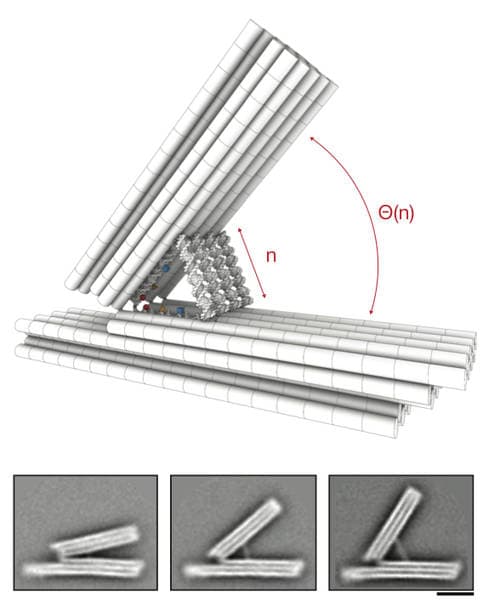DNA Origami Gets A Boost With Newly Constructed Nanoscale Rotor and Gripper
A research group at the Technical University of Munich (TUM) has uniquely designed two nano scaled rotor based machines using self-assembling DNA as the core material. In two consecutive scientific papers mentioned later, the team described a rotor mechanism based upon intertwined 3-D DNA components and a DNA made hinged molecular manipulator.
“DNA Origami†is a relatively new innovation where nano scale foldings of DNA are incorporated to result in a non-arbitrary 2D and 3D shaped nano-scaled objects. Customizing the definition, the research group has intuitively reciprocated plants’ internal mechanism inside programmable DNA to devise shape-complementary structure with interlocks.

Molecular manipulator made from DNA
Owing to their preceding work, the scholars’ team had come up with two new mechanical products. Doctoral students Philip Ketterer and Elena Willner worked together with with Dietz in shaping a rotory mechanism from three multilayer DNA building blocks consisting of a rotor unit, a 32 nanometers long chassis and a level like extension with greater height, and two clamps which forms an axle. Including 2 variants, namely free moving arm and dwelling arm, till date, these are the most complex structure engineered.
Dietz explained that this unique rotor project doesn’t have any motor, rather it spins due to the Brownian motion of particles in solution. In the hinged machine development, the angle between the gripper's two main sections could be precisely controlled using DNA helices which have set new records in terms of exactly positioning molecules and adjusting them.
The new advancement in chemical biology and engineering might replace electrical motors with the DNA based rotor mechanism which performs better in every aspect compared to the conventional ones. The research was reported in Science Advances and Nature Nanotechnology journals and was generously supported by European Research Council, the German Research Foundation (DFG), the German-Israeli Project Cooperation, and the TUM International Graduate School for Science and Engineering.
Source: #-Link-Snipped-#
“DNA Origami†is a relatively new innovation where nano scale foldings of DNA are incorporated to result in a non-arbitrary 2D and 3D shaped nano-scaled objects. Customizing the definition, the research group has intuitively reciprocated plants’ internal mechanism inside programmable DNA to devise shape-complementary structure with interlocks.

Molecular manipulator made from DNA
Owing to their preceding work, the scholars’ team had come up with two new mechanical products. Doctoral students Philip Ketterer and Elena Willner worked together with with Dietz in shaping a rotory mechanism from three multilayer DNA building blocks consisting of a rotor unit, a 32 nanometers long chassis and a level like extension with greater height, and two clamps which forms an axle. Including 2 variants, namely free moving arm and dwelling arm, till date, these are the most complex structure engineered.
Dietz explained that this unique rotor project doesn’t have any motor, rather it spins due to the Brownian motion of particles in solution. In the hinged machine development, the angle between the gripper's two main sections could be precisely controlled using DNA helices which have set new records in terms of exactly positioning molecules and adjusting them.
The new advancement in chemical biology and engineering might replace electrical motors with the DNA based rotor mechanism which performs better in every aspect compared to the conventional ones. The research was reported in Science Advances and Nature Nanotechnology journals and was generously supported by European Research Council, the German Research Foundation (DFG), the German-Israeli Project Cooperation, and the TUM International Graduate School for Science and Engineering.
Source: #-Link-Snipped-#
0
